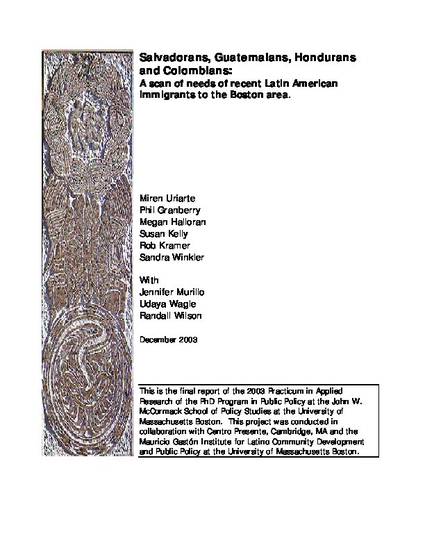
The 2000 U.S. Census brought confirmation of the increase of the Latino population and of the growing diversity of Latino national groups that now make this region their home. Latinos now number 428,729, a 55% increase over their numbers in 1990. In 30 years, the Latino population has increased six-fold, and from its initial concentrations in Springfield, Holyoke, and Boston its presence is now a fact across the Commonwealth.
Massachusetts Latinos are also showing increasing diversity, matching that of the Northeast region and exceeding that of the nation. At the national level, Mexicans have a dominance that dwarfs all other groups: 59% of all Latinos in the US counted by the Census are Mexican. Puerto Ricans and Cubans, the next two largest groups, are many numerical steps behind. In the Northeast region, Puerto Ricans dominate but not in such an overwhelming way. They account for 40% of the region’s Latinos; there is also a salient representation of Dominicans, Salvadorans, and Colombians. In Massachusetts, Puerto Ricans compose the largest group, accounting for 46% of the Latino population, followed by Dominicans, Mexicans, Salvadorans, and Colombians.
The diversity of the Latino population in Massachusetts began to be visible during the 1980’s and took frank hold in the 1990’s. Puerto Ricans arrived in the region in large numbers after World War II and settled in Springfield, Boston, Holyoke, and Lawrence. Until 2000, Puerto Ricans made up the majority of the Latino population of the state. In fact, they continue to exhibit a healthy rate of growth: 36.4% in the last 10 years.
But in this period, groups of other Latin American origin have experienced even greater growth. Dominicans, Mexicans, and Central and South Americans have experienced rates of growth in the range of 60 to 70% in the last 10 years. Dominicans are the second largest group in the region, accounting for 11.6% of the Latino population. The growth of the Mexican population has also been significant, making this group the third largest in the region today.
Available at: http://works.bepress.com/miren_uriarte/10/

This is the final report of the 2003 Practicum in Applied Research of the PhD Program in Public Policy at the John W. McCormack School of Policy Studies at the University of Massachusetts Boston. This project was conducted in collaboration with Centro Presente, Cambridge, MA and the Mauricio Gastón Institute for Latino Community Development and Public Policy at the University of Massachusetts Boston.